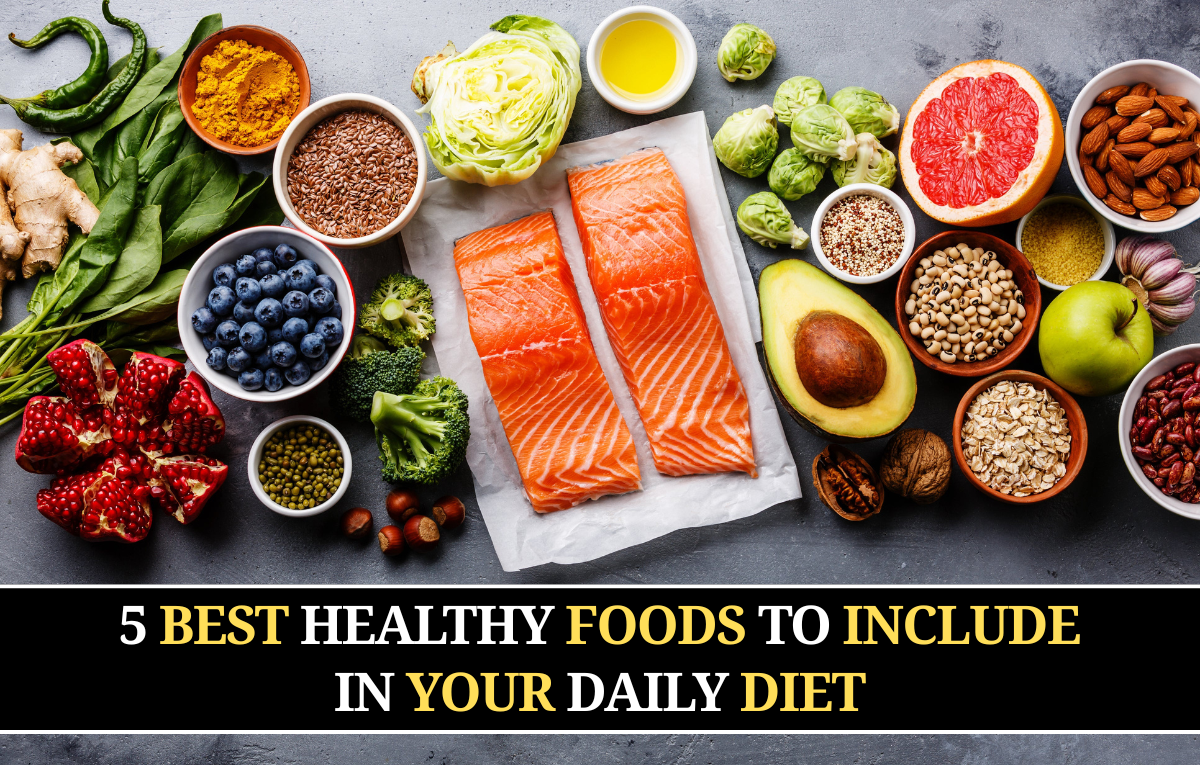Maintaining health has turned into a serious issue in the modern fast-paced lifestyle. We are so engrossed from dawn till dusk that eating comes to be a way of satisfying your stomach, rather than a way of enhancing your health.
In a hustle-bustle world, most people in a rush tend to go to fast-food joints and maybe order some processed food or fried items from outside. Attractive as they may seem, they harm us with the passage of time. Some diseases such as obesity, blood pressure, diabetes, fatigue, and heart problems are consequences of unhealthy eating habits.
The brighter side on the other hand, is that we can become healthier, with more energy, immunity, and mental balance, by simply considering adding the right foods in our regular diet. Such food can taste good; in fact, healthy food can hardly be boring if it is eaten consciously and can easily be filling and tasty.
Within this article we are going to review the top five healthy foods that even nutritionists recommend consuming as part of your daily diet. We will not only review what makes these foods important, but we will cover how to add them to your daily diet with ease.
1. Leafy Green Vegetables – The Nutrient Powerhouses
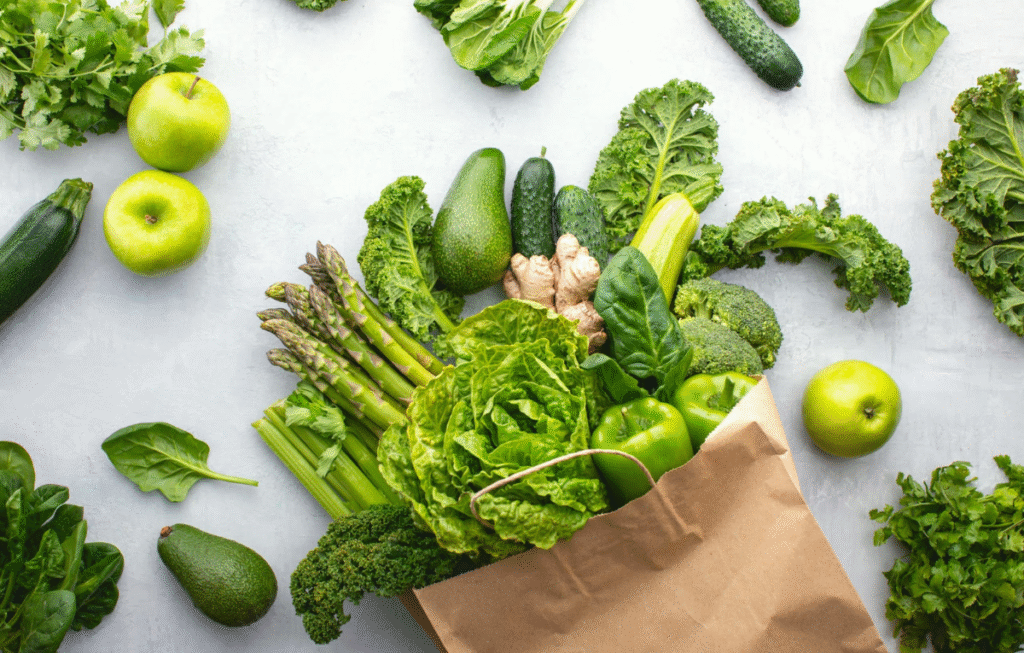
If someone asks you what foods are the healthiest in the world, green leafy vegetables will most probably be your answer. These are spinach, kale, fenugreek, mustard, amaranth, lettuce, bathua, and cabbage.
The best advantage of these vegetables is that they contain very few calories but are supercharged with vitamins, minerals, and antioxidants. Thus, the downside that you would gain weight just by eating a large volume of these foods is not a concern.
Why Leafy Greens Are Essential
- It is because they contain good amounts of vitamins A, C, K, folate and iron.
- They are very good for the heart as the nitrates present in them lower blood pressure.
- The fiber they contain aids with digestion, helps relieve constipation, and keeps the intestine healthy.
- They are ideal for weight loss because they are nutrient dense with low calories.
How to Add Leafy Greens to Your Diet
- Smoothie – Blend spinach or kale with banana and apple, and top with almonds.
- Salad – Mix with tomato, cucumber, carrots and peanuts – add a light dressing.
- Food – pair spinach paneer, mustard greens, fenugreek paratha, bathua raita.
- Wraps – as an alternative to a tortilla wrap vegetables stuffed in large leaves of lettuce.
Tip: When you report to the office and do not wish to carry a heavy lunch box, carry only spinach and tomato salad, a drizzle of a little olive oil.
2. Whole Grains – Long-Lasting Energy Source
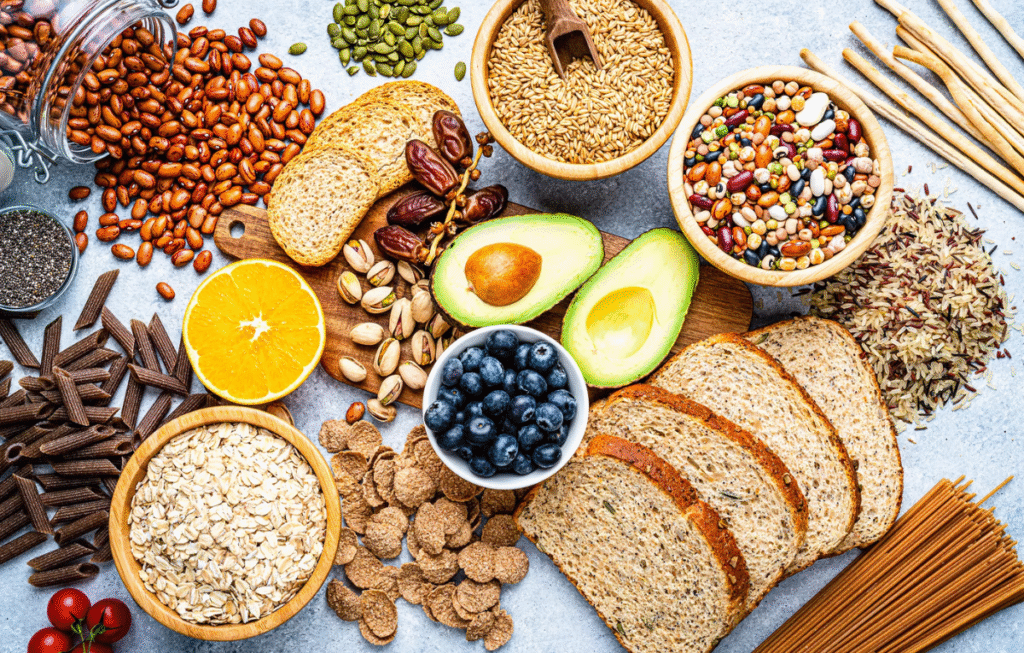
These days, people take white rice, refined flour, and baked white bread for the meal. Though these can stave off hunger for some time, they get quickly digested, shock glucose levels to rise, and then collapse, leaving the person hungrier and weaker.
Whole grains supply energy for longer: brown rice, quinoa, oats, barley, multigrain bread, etc. Whole grain mostly consists of all fiber and nutrients since they include the entire bran, germ, and endosperm.
Benefits of Whole Grains
- They provide slow energy release to stabilize blood sugar.
- They contain fiber which is beneficial for digestion and gut health.
- They’re good for the heart as the lower cholesterol.
- They help provide a feeling of fullness to avoid overeating.
Ways to Incorporate Whole Grains
- Breakfast: Oatmeal with nuts and fruit.
- Lunch/Dinner: Brown rice or quinoa instead of white rice.
- Snack: Hummus with air-popped popcorn or whole-grain crackers.
- Baking: Bake using whole wheat flour instead of white flour.
Tip: If paratha is your go-to breakfast, mix it up from time to time with barley or millet bread to change the taste and increase nutrient content.
3. Lean Proteins – The Building Blocks of Health
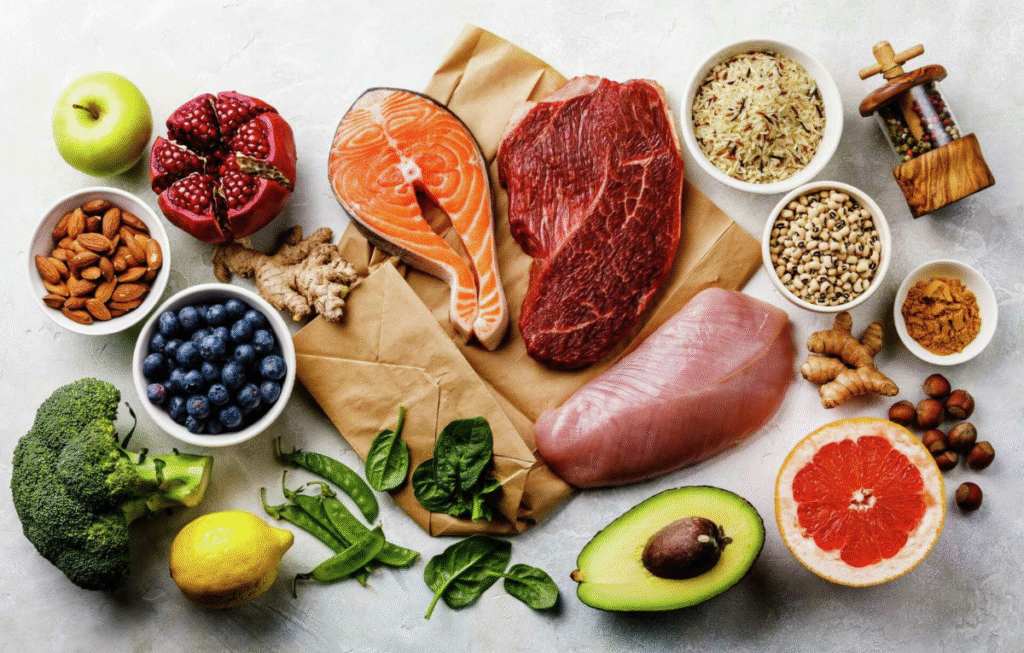
Protein is required by every single cell in the body. It creates our muscles, skin, hair, and nails. It repairs tissue and strengthens the immune system.
It’s important to eat the right kind of protein. Lean protein is the protein that has little or no saturated fat.
Best Lean Protein Sources
- Non-vegetarian Protein: Skinless chicken and turkey, fish, eggs, low-fat milk
- Vegetarian Protein: lentils, chickpeas, kidney beans, tofu, tempeh, quinoa, soybeans (edamame).
Why Lean Protein Matters
- Increases metabolism: It takes more calories to digest protein.
- Promotes satiety: it keeps you full longer.
- Enhances immunity: nuts contain amino acids healing the immune system in producing antibodies.
Easy Ways to Add Protein
- Breakfast: Greek yogurt, boiled egg, protein shake
- Lunch: grilled chicken or tofu salad
- Dinner: brown rice with lentils or fish
- Snacks: Roasted chickpeas or seeds.
Tip: When, for instance, you are working out in the gym, be sure to eat protein-rich foods afterward, like egg whites or a glass of milk.
4. Nuts and Seeds – Tiny but Mighty
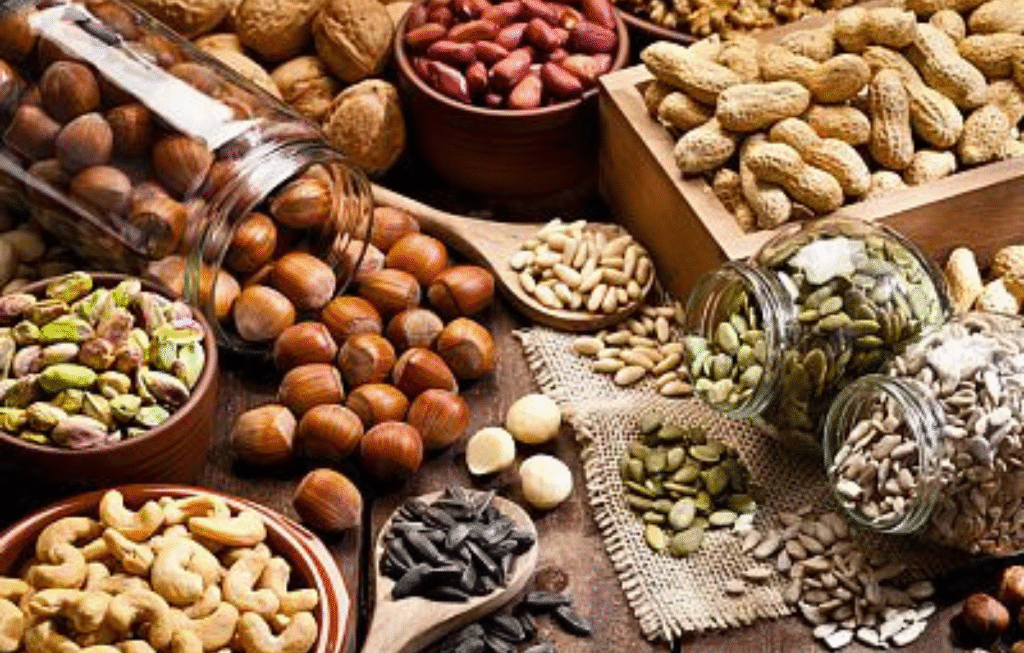
Nuts and seeds are usually shunned for their calorie load, but they are superfoods. They pack healthy fats, plant proteins, fiber, and antioxidants.
Nutritional Benefits
- Omega-3 fatty acids address inflammation and heart health.
- Minerals such as magnesium, zinc, and selenium aid in important body processes.
- Brain-friendly: Walnuts and flax seeds enhance memory and concentration.
- Skin and hair friendly: Vitamin E in sunflower seeds and almonds induces glow and strength.
How to Eat Nuts and Seeds Daily
- Snack: A mix of handful nuts.
- Breakfast topping: Sprinkle chia, flax, or pumpkin seeds on oats, yogurt, or smoothie.
- Nut butter: Almond or peanut butter on whole-grain bread.
- Cooking: Sprinkle sesame seeds on vegetables or stir-fries.
Tip: Rather than a tea with biscuit at work, have a few roasted almonds or pumpkin seeds.
5. Fresh Fruits – Natural Sweetness and Nutrition
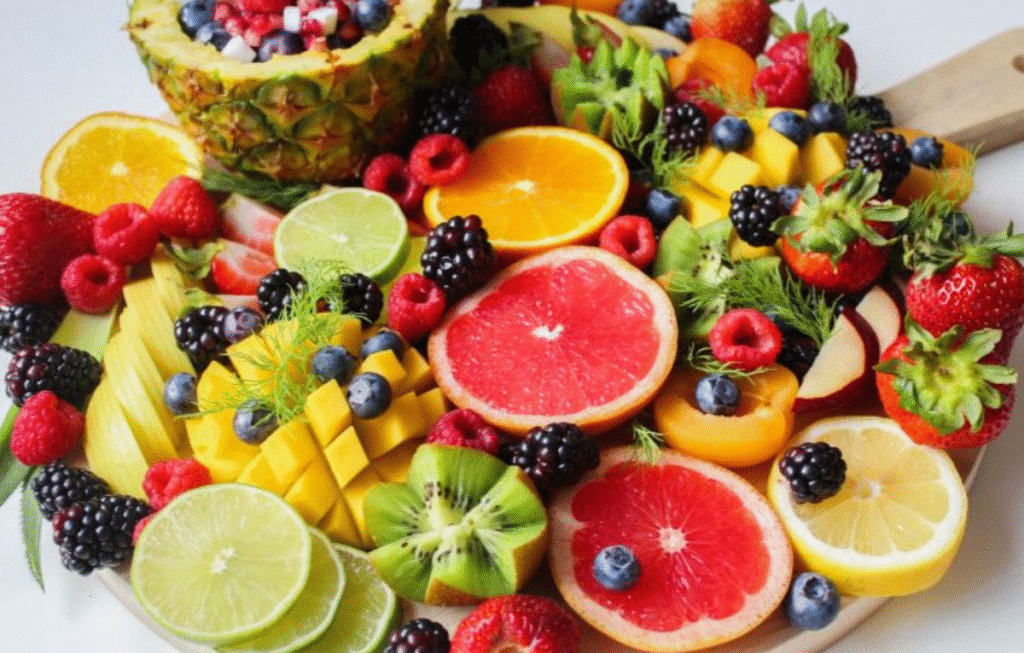
Fruits are nature’s most delectable and nutritious gift. They are sweet as well as full of nutrients essential for our health.
Benefits of Fruits
- High in antioxidants: Delays aging and guards against disease.
- Immunity booster: Fruits like oranges and lemons contain high levels of vitamin C.
- Enhances digestion: Papaya and pineapple are enzyme-rich.
- Hydration: Watermelon and cantaloupe have high water content.
Best Fruits for Everyday Diet
- Berries: Low sugar, antioxidant-rich.
- Bananas: Quick energy and potassium.
- Fruits that are citrus fruits: Orange, sweet lime, and grapefruit.
- Apples and pears: Fiber is filling.
Tip: If you need a sweet fix at night, eat a fruit salad bowl instead of chocolate.
Building a Balanced Plate with These Foods
Offered here is the healthiest way to eat:
- Half a plate for veggies and fruits
- A quarter of a plate for whole grains
- A quarter of a plate for lean proteins
- A little handful of nuts or seeds or an extra drizzle of olive oil
Sample Daily Meal Plan Using These Foods
- Breakfast: Oatmeal + chia seeds + banana + almond butter
- Mid-morning snack: Mixed fruit + yogurt
- Lunch: Quinoa salad + grilled chicken + spinach + tomato
- Evening snack: Walnuts + sunflower seeds
- Dinner: Brown rice + lentils + sautéed spinach
Conclusion
When incorporated in one’s daily diet, these five healthy foods-dark green leafy vegetables, whole grains, lean protein, nuts and seeds, and fresh fruit-make a difference in the realm of health. These foods will offer you energy and nutrition, boosting immunity, supporting healthy skin and hair, and ensuring that you remain active throughout the day.
Consider healthy nutrition to be a road that never leads to starvation or some radical diet. Healthy means creating habits in stages, step-by-step, and ones that the mind and body can sustain. Start anywhere, and take small steps.
With time, you will find these foods are naturally part of your daily menu, and you will feel the difference in your own body by improved digestion, more energy, skin clarity, and immune enhancement.
FAQs:-
What are the 5 best healthy foods to eat every day?
Leafy greens, whole grains, lean proteins, fruits, and healthy fats like nuts or seeds.
Why should I include these 5 foods in my daily diet?
They provide essential nutrients, improve energy levels, and support long-term health and immunity.
Can I prepare meals with these foods easily?
Yes, they can be used in salads, smoothies, stir-fries, or simple home-cooked meals quickly.

